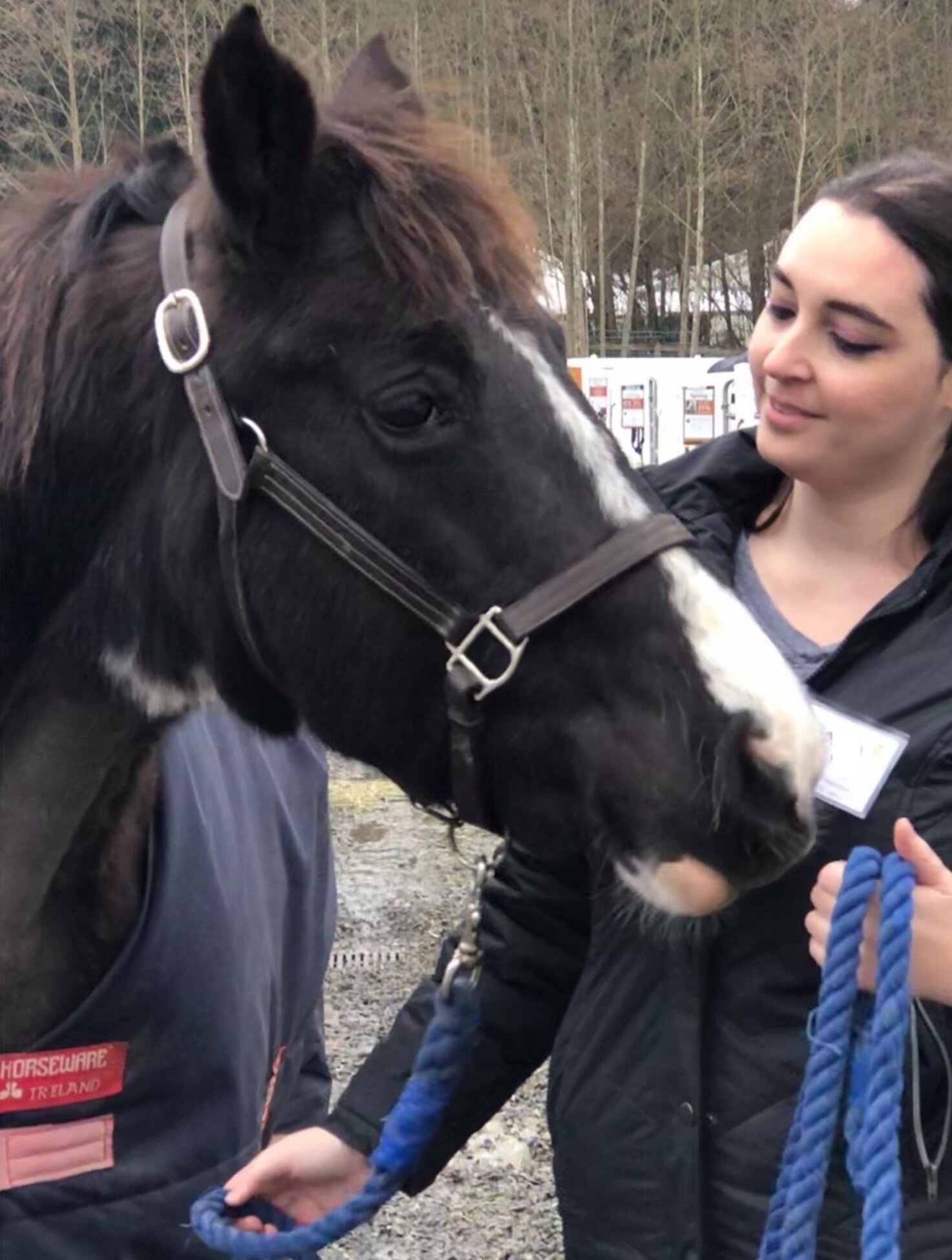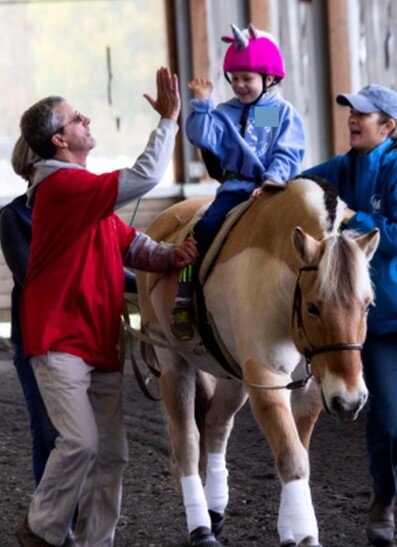During a recent survey, Little Bit Therapeutic Riding Center donors asked for more Little Bit stories, including stories featuring our volunteers. Sharing Little Bit stories is one of our favorite things to do! If you have witnessed Little Bit programs in action, you know how vital our volunteers are. The number of Little Bit volunteers has increased every year from 2014 through 2019—they provide power and heart to the Little Bit mission!
We reached out to Soraya and Greg, two of our many dedicated volunteers, to ask them for their perspectives on the Little Bit volunteer experience.
How long have you been volunteering at Little Bit and what are your volunteer roles?
Soraya: I have been volunteering since January of 2019; I am trained as a horse leader in adaptive riding as well as a member of the training team that helps new volunteers. I also step in for hippotherapy when they are available because I love them.
Greg: I started volunteering in 2018 and am trained as a horse leader in adaptive riding. I help out with adaptive sessions but more often now with hippotherapy.
Why do you carve out the time to volunteer at Little Bit when you have so much on your plate?
Greg: It is such joy to be there working with the riders, the staff, the therapists, and the horses. I don’t do it as a selfish reason, but I do get a lot of joy out of it. Just to see the rider’s face if they are able to overcome a fear or accomplish something, that interaction. I learn so much about the different riders and horses. It’s quite enjoyable for me.
Soraya: For me, volunteering at Little Bit is my recharge station. Doing a lot of high stress things on a day to day basis, it really helps to have a place to go. Being around horses recharges me—seeing the riders get through things, like Greg said, learn things, overcome fears—that also recharges me and makes me feel ready to go back into whatever I need to do that day.
Do you have a favorite rider or patient experience since you’ve been at LB?
Soraya: One of my favorite experiences is watching a rider bond with a horse for the very first time, especially in hippotherapy sessions. Sometimes it takes a while to find the right horse for the right rider. They’re all great, but there are certain personality matches that just click. I remember subbing for a therapy session where the kid was extremely high energy and had trouble focusing on therapy. He had previously been put on slow horses that were very calm, and that wound up being too little stimulation for him. They tried him with Spring who is very high energy, very up and go. That match was love at first sight. You could see over the course of less than 10 minutes the patient went from being distracted to focusing.
Greg: What first came to mind was seeing the same rider and horse over a few weeks—you get acquainted. You’re not just someone at the head or side of a horse. It’s meaningful when that connection is a little bit stronger, whether it’s a simple smile of recognition or some type of communication to me. I’m there to kind of help, but then to see that little bit of change, it’s just a reward. I remember there was one time one of the therapy patients came in, and it wasn’t a good day for her. All of a sudden, it changed. The therapist’s eyes beamed as if to say, this is great. It’s going to be a different day.
Do you have any experiences to share about your interactions with other volunteers at Little Bit?
Greg: I became acquainted with Little Bit because one of my staff had been volunteering there. She knew I felt comfortable working with horses. Unfortunately, we never got to volunteer at the same time. There was an occasion when I knew another volunteer from years before. It was great to have that little bit of connection. When we were volunteering together, it was fun to chat with each other during the warm-up. I have another colleague whose daughter is a rider, and I’ve been able to see his wife and their kids on occasion at Little Bit. The program reaches out a good distance from Redmond, and so it’s good to appreciate that people are coming from many locations and many walks of life. Sometimes there is some familiarity from another circle of involvement.
Soraya: I’ve forged new friendships there. There have been a couple of times when I worked shifts at odd hours, and during those quiet times you really get to know the volunteers you’re working with. One of my first friendships at Little Bit was with a woman who I had not met before. We wound up, every morning, chatting about what was going on in our lives. When there was a group of people who were all working Friday afternoon, we often spent extra time hanging out at the stables after the classes were done. We would help clean out the stable and feed horses to get a few more minutes in. I’ve definitely found that forging friendships with other volunteers at Little Bit has been another reward.
If you were trying to convince someone to volunteer at Little Bit, what would you say to them?
Soraya: I tell them that volunteering at Little Bit is one of the most rewarding things I do every week. It’s a great way to reconnect and actually see the good results of what you’re doing. I also tell them that you don’t need to be intimidated if you don’t know that much about horses yet, because the people at Little Bit will really walk you through it and will be patient as you learn—and they’ll also teach you really good practices so that you are safe around horses.
Greg: I’ve invited others to join. You don’t have to be leading a big horse or be concerned about the rider and the horse. You can help out at the barn. I saw volunteers build some of the sheds outside at the paddocks. I would love for my son and I to spend an afternoon and just knock-out a couple of those. There are lots of different ways to volunteer. It doesn’t always have to be so intimately engaged with the horses. When I had a barn, it was therapy for me, just to get in there, have a sense of accomplishment, and interact with the animals. There are lots of ways to help. It’s just a matter of encouraging someone to come along, look at the place, and find a place that is suitable for their interests and abilities.
Do you have a favorite horse at Little Bit?
Greg: I don’t have a favorite horse; there are some that I like more than others. It’s really the ability to work with a horse over several weeks to get acquainted. Even now coming back, I’ve had to get reacquainted. I have to remember I can’t cross-tie Sherman and when I need to bring a crop because that horse is going to dive for grass every opportunity. I would love to get to a place where a horse nickers when I approach. Sherman did that a couple times when I was working with him week in and week out. It’s great to receive that kind of recognition, and it doesn’t require treats in my hand to get that.
Soraya: I absolutely do play favorites. My favorite is Davida. There was a time when I was working with her week in and week out, in an adaptive class, and it was always such magic to see her in the warm up: she’s very alert and she demands that you be very alert so she knows that you are looking out for her. Then the rider arrives and she becomes this gentle, sweet thing. She pays so much attention to the rider that she’s working with, trying to do what she can to help them. I really love how she goes from making high demands of people that work with her on the ground to being an attentive caretaker for people that are on her back. It feels like she is asking the people on the ground, “Hey, I’m about to work and I want to make sure that you’re ready to work with me.” Davida is a very big favorite of mine.
There will be people who read this who have never been to Little Bit. How would you describe the Little Bit experience to someone whose knowledge of Little Bit is limited to stories and videos?
Soraya: I would describe it as being around the kindest, most attentive people that you can find. Everyone at LB is always trying to help each other out. There isn’t a sense of judgement ever; there isn’t prying. How can we help each other out? I love the attention to detail, like checking on the horses and sweeping a little muck out of the area. The therapist or instructor helps the rider rearrange their pants leg after it’s been pulled up by the saddle. All of these little things come together to form this place. You know how much work is getting done, you see how much work is getting done, and yet the people who are doing all that work make it look simple. They’re handling it, they’re here to care for people, and they’re willing to put so much energy into making everyone else have this great experience.
Greg: What I love about the name Little Bit—it’s kind of a philosophy in that sometimes we don’t know how much we help by the little efforts we offer, whether it’s helping someone adjust a cuff or cleaning the stall. In the lives of the riders and their families, they’re looking for help in many ways, some specific and some not. We get to contribute a very, very small part, just a little bit, in helping them. That gracefulness of helping people, that gratitude of being thankful for the assistance others give us, I think is prevalent throughout the organization. It’s very rewarding to see, and not take any credit for it, but to see someone say thank you. That smile on their face, that nod of appreciation. That’s what’s very attractive about the whole outfit—from reception to throughout the stalls and every aspect.
What adjustments have you seen Little Bit make, and you personally have had to make, related to the pandemic?
Greg: I think it is well thought-out with the understanding that the process has been considered and evaluated. It’s also adjusted as needed. I personally feel safe. There are many things in place to help make it safe for all people involved. I kind of expected it but I’m glad to see it. Sometimes it’s great in plan or in theory, but in practice is sometimes where things trip up or you forget a detail. After talking to the staff and understanding that we’re going to make adjustments, all those items are terrific.
Soraya: The adjustments that I’ve seen since returning have been impressive. A lot of things changed. For example, each horse no longer has their assigned tack box. Now, a volunteer gets in, they pick their own tack box, and it’s just theirs for the day. Then those have to get cleaned and washed and can’t be shared. These are really good thought processes and really effective at minimizing how many people are contacting the same things. Over time, I’ve seen pieces of that which worked and pieces which didn’t work. I’ve watched the staff adapt to each of those changes, adapt rules about who can go into the tack barn and how we’re going to put horses into individual stalls. People are being really flexible about working together and accepting change. Everyone is actively looking out to make sure we are doing things safely.
How are you acknowledged as a volunteer within Little Bit?
Soraya: One of the things that means a lot to me at Little Bit is how many therapists, staff, and other volunteers make the effort to learn and remember my name, which is a tricky one to pronounce. (So-RAY-ya, “Ray like sunshine,” I like to say!) It’s always meaningful when I sub in for a class and maybe I haven’t seen that staff member for weeks or months. A surprising amount of the time, they remember my name, and if they don’t, they make the effort to be polite and ask. Then they refer to me by name during the class. “Turn towards Soraya.” It’s a small touch that means a lot to me to show that they care that I am there.
Greg: Outside of Little Bit, there have been a few occasions where I’ve encountered some staff members. In every instance both of us stop what we’re doing and just have a chat. Sometimes you see an acquaintance from one area of our lives and pass them with a completely different backdrop, and 1.) Do you remember who it is, 2.) Do you remember the person’s name, but 3.) Are you able to stop what you’re doing and have that brief conversation—it’s great, you kind of feel a part of it. It’s a big organization and there are so many volunteers. It’s great to see the recognition and the time that it takes.
Is there anything else you’d like to share?
Greg: A part of the organization I’d like to explore more is how to donate horses; I’ve owned horses myself, and at the time our place was considered a geriatric barn. I’d like to understand how to donate a horse or sponsor a horse, to be able to think of a horse that might be suitable for the program.
Soraya: One of the things I don’t have many opportunities to say thank you for are the folks that work the office. They have always been incredibly helpful and understanding. Whenever I’ve brought up an idea for improvement or concern, I’ve been met with understanding and support. Even picking up volunteer shifts that need a substitute, people are completely understanding. If I can make it, great; if I can’t, no problem at all. I can tell how much people are giving to the job, both in the stables and at a desk.
Thank you
to Greg, Soraya and all of our dedicated volunteers!
Written by Sharon Soldenwagner
























